Numerical modeling - the story of one project
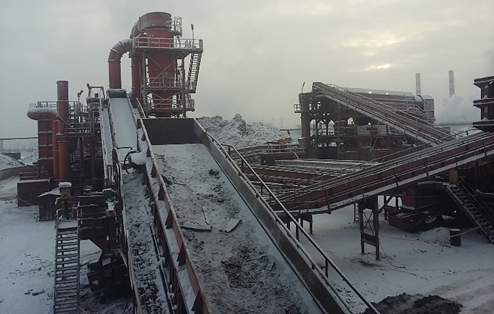
Hello, Habr and his dear readers!
In the article ( link ) we talked about our experience in introducing numerical modeling tools into the research practice of a metallurgical company. We are glad that the topic has found support and aroused the interest of the resource readers. Today we will talk about the practical side of the issue of the application of numerical methods for solving applied problems, namely, the progress of one of our projects. It will be about the industrial shredder plant designed for grinding scrap metal and cleaning it from impurities.
The raw material for the shredder is scrap metal, and the result of the work is metal meal. Grinding scrap metal allows you to increase its bulk density, and most importantly, to sort and remove impurities, including non-ferrous metals, which are also recycled, but separately.
The object of our research was the support frame of the vibrating chute transporting the meal from the shredder to the conveyor belt. In order for the meal not to linger in the vibratory chute, the chute itself is subjected to dynamic loads - it vibrates.
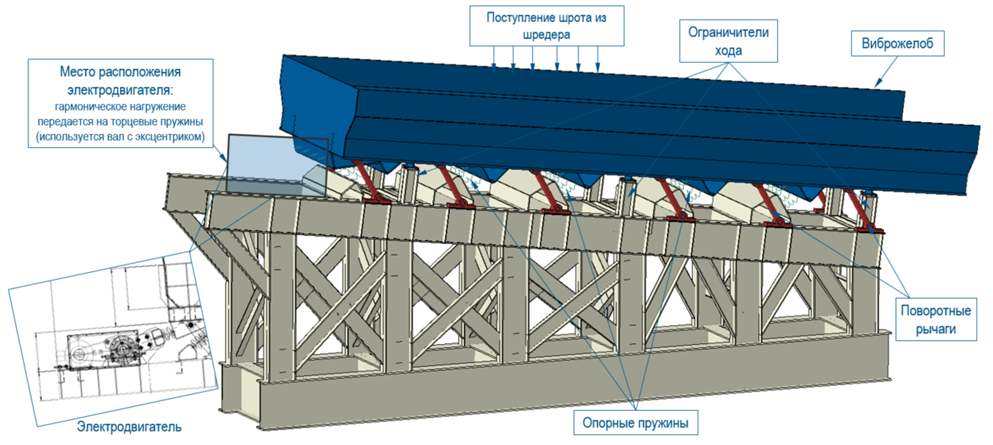
Geometric model of vibro-groove and support frame
During equipment maintenance, cracks on the support frame began to be detected, mainly along the weld seams. The reason for the formation of damage could not be established by conventional methods, mainly because during the operation of the shredder personnel access to it is prohibited. It was necessary to develop and implement measures aimed at eliminating the causes of cracking and improving equipment reliability. The goal of our participation is to verify the hypotheses formulated by the customer on the mechanism of the destruction of the support frame and possible corrective actions using numerical simulation methods.
The most problematic stage of work was the collection of basic data. In theory, the geometry of the object (drawings or finished geometric models), data on the mechanical characteristics of materials and loading conditions are provided to the calculator as source data. The accuracy of the source data directly affects the reliability of the results of the calculation model. In our project, a significant amount of data was not available, and these gaps were filled with “manual” measurements.
As a result, a geometric Schröder model was assembled, a finite element model was constructed, all the mounting conditions were arranged, and calculations were started.
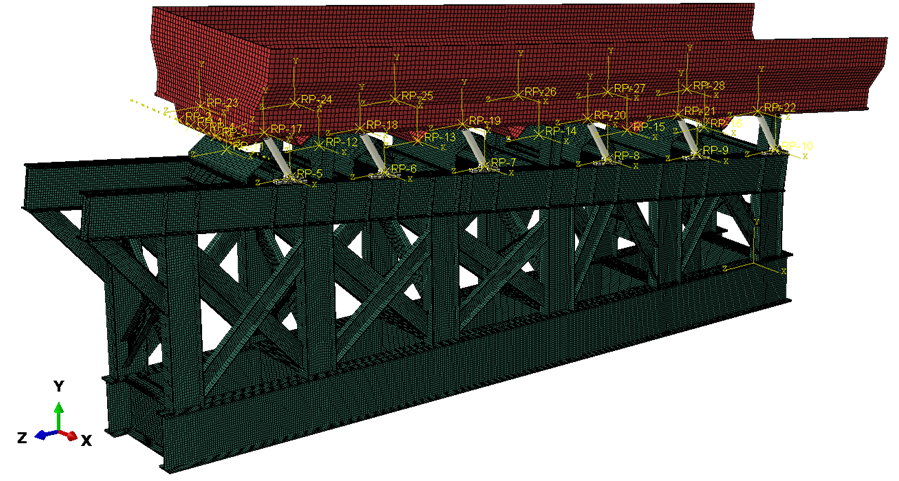
Finite element model: Sheet metal structural elements were approximated by shell finite elements (EC); attachment points of the swivel arms - solid-state CE; rotary levers - beam CE
We began with an assessment of the static strength of the structure. External loads: own weight of the structure and the mass of the meal at a different level of filling of the vibrating chute. Static analysis showed that even when the gutter was fully loaded with meal, the level of mechanical stresses was significantly lower than the limit values and could not be the cause of the destruction of the metal structure.
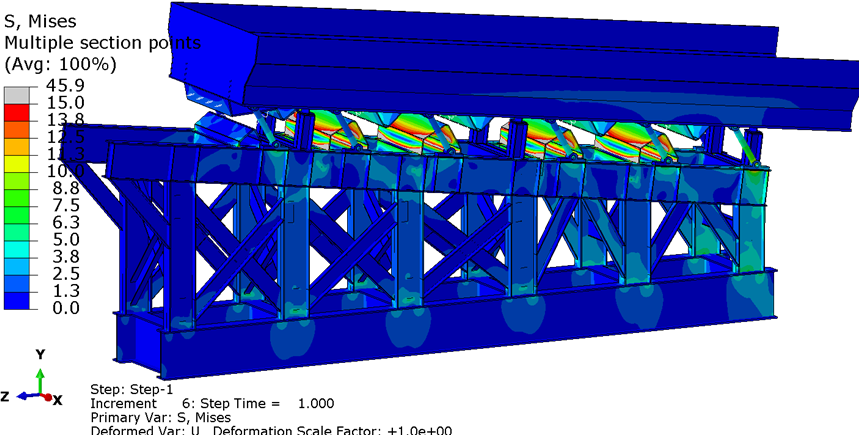
Static analysis: the distribution of equivalent von Mises at full load of the gutter with meal, MPa
Frequency analysis of the structure showed that the frequency of the external harmonic load is close to the frequency of oscillations in the 3rd proper form, which can cause resonance.
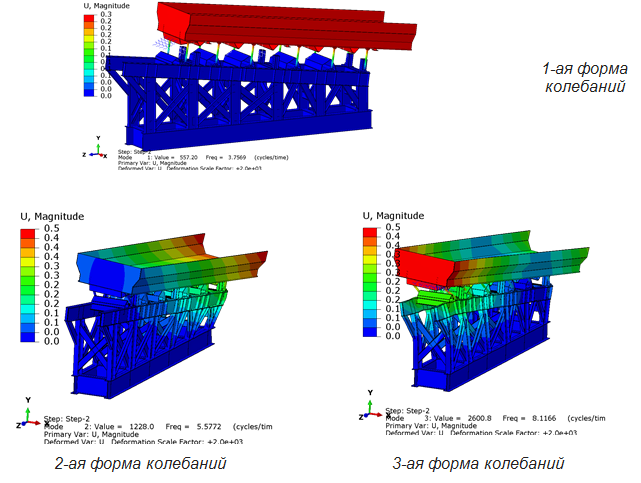
What happens to the design of the support frame when resonant oscillations occur?
To answer this question, a series of linear (modal dynamics) and nonlinear dynamic calculations were carried out, in which we intentionally tried to introduce a system into resonance. The following parameters varied: external load frequency ± 15% of the base value, filling level of the body of the chute with grit (affecting the dynamic characteristics of the system) and spring stiffness ± 15% of the base value. Values of variable parameters and their combinations were obtained, which lead to the appearance of resonant oscillations.
The analysis revealed that resonant oscillations lead to shock contact interactions between the surfaces of the travel stops. The levels of mechanical stress at the moment of impact exceed the limiting value, which can cause the destruction of metal structures. We found evidence of this during the re-inspection of the installation: at the time of the inspection, a number of stoppers were missing rubber dampers; two end stoppers are plastically deformed, which indicates impacts during operation.
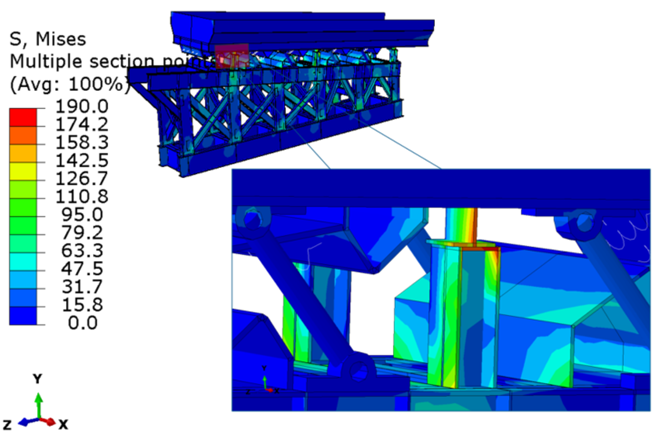
Nonlinear dynamic analysis: the distribution of equivalent von Mises stress at the moment of impact on the surfaces of the travel stops, MPa
According to the results of the work, we made the following conclusion: the most likely cause of failure is the resonant vibrations of the structure and, as a result, impact-contact interactions on the surfaces of the travel stops. The reasons for the occurrence of resonant oscillations according to the current model (taking into account the accuracy of the original data) can only be conditionally spoken: engine operation at off-design rotational frequencies; wear of the gearbox and actuators, which entailed a change in the frequency of the external load; "Fatigue" springs. The work has not yet been completed, we are now refining the model using updated baseline data.
In terms of the application of the finite element method (FEM) to solve practical problems in industry, this project clearly demonstrates that:
- FEM allows you to explore and analyze processes that cannot be observed physically, for example, due to the restriction of access for security reasons, environmental conditions, or processes that occur in confined spaces;
- the analysis carried out using the FEM with fairly accurate reproduction of the real physics of the process allows us to detect critical process parameters, even if they were not formulated in the initial hypotheses;
- One of the main limitations of the practical application of the FEM is the insufficient quality of the initial data that we face in most of our projects.
For lovers of technical information, we inform you that this work was carried out using SIMULIA Abaqus software on the Lenovo ThinkStation P720 billing station (Xeon Silver 4108 processor, 128 GB of RAM). Depending on the type of analysis (static or dynamic), the dimension of numerical models ranged from 50 to 300 thousand finite elements; the duration of calculation of models is about several minutes for static analysis and up to an hour for dynamic. In general, all the work from the beginning of the collection of initial data to the formation of the report and the issuance of recommendations took 1 month.
This article was written in collaboration with my colleague Dmitry Nushtaev, a mechanical engineer, Ph.D.
